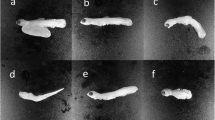Abstract
The role of the jelly coat in providing a protective barrier to chemical absorption was studied using the embryos of the amphibian, Xenopus laevis. Embryos with or without a jelly coat were water exposed to the butoxyethyl ester of 2,4-dichlorophenoxyacetic acid (2,4-D BEE) and the rates of uptake, metabolism, distribution, and excretion were determined. The water uptake clearance rates were slower for embryos with a jelly coat (1.5–4.5 mlwater·g −1embryo ·h−1 or 0.040–0.022 mlwater·h−1 per embryo) in comparison to dejellied embryos (14–21 mlwater·g −1embryo ·h−1 0.0066–0.021 mlwater·h−1 per embryo). This accounted for the much lower residues in embryos with a jelly coat than in dejellied embryos during 8 h of exposure. Despite quantitative differences in uptake, once 2,4-D BEE had entered the embryos, metabolism and distribution were similar between the two test groups. 2,4-D BEE was metabolized to 2,4-dichlorophenoxyacetic acid (2,4-D) with half-lives ranging from 35 to 42 minutes. The radioactive residues, as determined by whole body autoradiography, appeared throughout the embryo with a slight accumulation in the blastocoel. Furthermore, 35% of the radioactive residues were located in the jelly coat and 65% in the developing embryo. Based on a slower 2,4-D elimination in embryos with a jelly coat, the diffusive properties that decreased 2,4-D BEE uptake appeared to similarly decrease elimination of its metabolite. The common practice of removing jelly coats prior to embryonic amphibian toxicity studies, as in the widely used Frog Embryo Teratogenesis Assay–Xenopus (FETAX), is discouraged based on the kinetic differences observed in this study.



Similar content being viewed by others
References
American Society for Testing and Materials (1992) Standard guide for conducting the Frog Embryo Teratogenesis Assay–Xenopus (FETAX). E1439-91. In: Annual book of ASTM standards, vol 11.04. Philadelphia, Pennsylvania, pp 1199–1209
Barron MG, Mayes MA, Murphy PG, Nolan RJ (1990) Pharmacokinetics and metabolism of triclopyr butoxyethyl ester in Coho salmon. Aquat Toxicol 16:19–32
Berrill M, Bertram S, McGillivary L, Kolohon M, Pauli B (1994) Effects of low concentrations of forest-use pesticides on frog embryos and tadpoles. Environ Toxicol Chem 13:657–664
Berrill M, Coulson D, McGillivary L, Pauli B (1998) Toxicity of endosulfan to aquatic stages of anuran amphibians. Environ Toxicol Chem 17:1738–1744
Delplace F, Maes E, Lemoine J, Strecker G (2002) Species specificity of O-linked carbohydrate chains of the oviducal mucins in amphibians: structural analysis of neutral oligosaccharide alditols released by reductive B-elimination from the egg-jelly coats of Rana clamitans. J Biochem 363:457–471
Edginton AN, Sheridan PM, Stephenson GR, Thompson DG, Boermans HJ (2004) Comparative effects pH and Vision herbicide on two life stages of four anuran amphibian species. Environ Toxicol Chem 23:815–822
Edginton AN, Stephenson GR, Sheridan PM, Thompson DG, Boermans HJ (2003) Effect of pH and Release on two life stages of four anuran amphibians. Environ Toxicol Chem 22:2673–2678
Gosner KL (1960) A simplified table for staging anuran embryos and larvae with notes on identification. Herpetologica 16:183–190
Griebeling KH, Cline GR, Rayburn JR (2003) Role of the jelly coat in the development of two frog species exposed to Roundup and diazinon, using FETAX. PM004. Presented at the 24th Annual Society of Environmental Toxicology and Chemistry Conference, Austin, Texas, USA, November 9–13, 2003
Licht LE (1985) Uptake of 14C DDT by wood frog embryos after short term exposure. Comp Biochem Physiol C Toxicol Pharmacol 81C:117–119
Licht LE (2003) Shedding light on ultraviolet radiation and amphibian embryos. Bioscience 53:551–561
Pauli B, Coulson D, Berrill M (1999) Sensitivity of amphibian embryos and tadpoles to Mimic 240LV insecticide following single or double exposures. Environ Toxicol Chem 18:2538–2544
Pinder AW, Friet SC (1994) Oxygen transport in egg masses of the amphibians Rana sylvatica and Ambystoma maculatum: convection, diffusion and oxygen production by algae. J Exp Biol 197:17–30
Rodgers CA, Stalling DL (1972) Dynamics of an ester of 2,4-D in organs of three fish species. Weed Sci 20:101–105
Seymour RS, Bradford DF (1995) Respiration of amphibian eggs. Physiol Zool 68:1–25
Syracuse Environmental Research Associates, Inc. (1999). 2,4-Dichlorophenoxyacetic acid formulations – Human health and ecological risk assessment. SERA TR 95-21-09-01d. http://www.fs.fed.us/foresthealth/pesticide/risk_assessments/09170224d.pdf Accessed May 10, 2006
Thompson DG, Wojtaszek BF, Staznik B, Chartrand DT, Stephenson GR (2004) Chemical and bio-monitoring to assess potential acute effects of Vision herbicide on native amphibian larvae in forest wetlands. Environ Toxicol Chem 23:843–849
Ullberg S, Larsson B, Tjalve H (1982) Autoradiography. In: Gleen HJ (ed) Biological applications of radiotracers, CRC Press, Boca Raton, pp 56–108
Wolf DP, Nishihara T, West DM, Wyrick RE, Hedrick JL (1976) Isolation, physiochemical properties, and the macromolecular composition of the vitelline and fertilization envelopes from Xenopus laevis eggs. Biochem 15:3671–3678
Yamaoka K, Nakagawa T, Uno T (1978) Application of Akaike’s Information Criterion (AIC) in the evaluation of linear pharmacokinetic equations. J Pharmacokin Biopharm 6:165–175
Acknowledgments
This work was funded by the Toxic Substances Research Initiative of Health and Environment Canada, and by the Natural Sciences and Engineering Research Council. The authors would like to thank Michael J. Castledine for graphics assistance.
Author information
Authors and Affiliations
Corresponding author
Rights and permissions
About this article
Cite this article
Edginton, A.N., Rouleau, C., Stephenson, G.R. et al. 2,4-D Butoxyethyl Ester Kinetics in Embryos of Xenopus laevis: The Role of the Embryonic Jelly Coat in Reducing Chemical Absorption. Arch Environ Contam Toxicol 52, 113–120 (2007). https://doi.org/10.1007/s00244-005-0215-4
Received:
Accepted:
Published:
Issue Date:
DOI: https://doi.org/10.1007/s00244-005-0215-4




